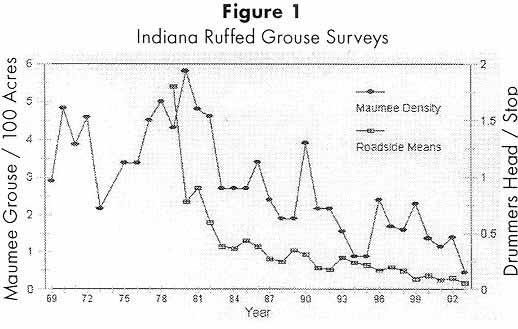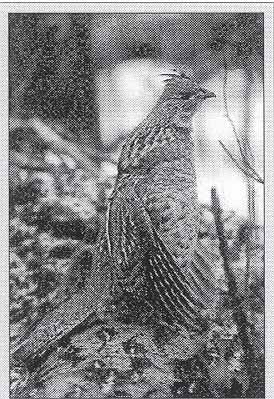
Summer 2003 Volume 12, Number 2
Breeding Indices of ruffed Grouse - Spring, 2003
By Steven E. Backs, Wildlife Research Biologist
Abstract: ruffed grouse breeding populations are at their lowest levels in over 2 decades. The 2003 drumming index for 8 survey control routes was 0.06 drumming males heard per stop compared to 0.10 in 1992 or 5% of levels recorded during the peak years of 1979-81. The 5 year mean drumming index (1999-2003) is 0.09 drummers per stop or approximately one drummer heard every 10 stops. prospects for population recovery are poor given the continual advancement of forest succession.
Federal Aid Pittman-Robertson Project/Research Job: W-26-R-34/Job 16-G-3; Work Plan #200302
_______________________________________________________________________________________
Ruffed grouse breeding population indices were estimated during the
spring of 2003 along 10 roadside drumming trend routes. The annual drumming
activity center count was conducted at the Maumee Grouse Study Area located on
Hoosier National Forest in Jackson/Brown counties. Roadside counts ranged from 0
to 0.13 grouse heard per stop (15 stops/route). The upper range of these values
has been relatively low since 1982 when a downward shift in the population cycle
became evident after a high in 1979. Three routes showed an increase, six routes
showed a decrease, and one had no trend change from the previous year. The
combined mean for the 8 control areas was 0.06 grouse heard per stop compared to
0.10 birds heard per stop in 2002. The 5-year mean drumming index (1999-2003) is
0.09 drummers per stop or approximately one drummer heard every 10 stops.
Drumming indices for the control routes indicate grouse breeding populations
have declined fairly steadily since the cyclic peak of 1979 and are only at 5%
of levels recorded during the peak years of 1979-81.
A total of 2 drumming activity centers was located on the Maumee Grouse Study Area for estimated spring breeding population density of 0.5 grouse/100 acres. Habitat on the Grouse Study Area is fairly reflective of habitat conditions on the Pleasant Run Unit of Hoosier National Forest. While there are some periodic fluctuations in the grouse breeding population density on the study area, there is a general downward trend as more mature forest conditions prevail. One of the activity centers located in 2003 was in an abandoned, overgrown wildlife opening (< 0.25 acre) while the other was in small, linear hardwood thicket (2 + acres) that regenerated after a small pine salvage cut approximately 15 years ago. Since active vegetation management is not allowed under the current management prescription for this area of Hoosier National Forest, these small ephemeral pieces of grouse breeding habitat are expected to disappear within the next 5 years. The Maumee Grouse Study Area lies in the heart of the 1961 remnant distribution of ruffed grouse (Backs 1984) used in the 1960-70's to reestablish ruffed grouse elsewhere in Indiana.

Roadside drumming indices and Maumee density estimates show fairly parallel downward trends over 2 decades (Figure 1). Advanced forest succession is the primary reason for the continual decline of ruffed grouse. Ruffed grouse habitat is primarily dense, early successional stages of hardwood that are disappearing in the major forest tracts in Indiana and the eastern United States. Data extracted from the 1998 inventory of Indiana's forests (Schmidt et al 2000) indicates the seedling/sapling/pole timber components of the Knobs Sampling Unit has steadily declined (-52%) since 1967, being replaced by mid to late successional saw-timber. The Knobs Sampling Unit covers a major portion of south-central Indiana and the primary range of existing ruffed grouse populations in Indiana. Similar declines in the seedling/sapling/pole components have also occurred across the Hoosier National Forest (Leatherberry 2003).
The proportion of seedling/sapling/pole
timber components are indicative of transitional habitats between grasslands and
mature forests used by a wide variety of wildlife species that historically
resulted from natural disturbances (e.g. tornadoes, fire, storms, insect
outbreaks). These types of transitional areas are not only habitat for game
birds as ruffed grouse and woodcock but a host of songbirds and mammals in the
eastern United States that are also undergoing significant and parallel declines
(See a series of papers in 'Conservation of woody, early successional habitats
and wildlife in the eastern United States" pages 407-494, Wildlife Society
Bulletin Vol. 29, No. 2, Summer 2001 ). Until public land managers again have
the flexibility and the public support to use various vegetation or timber
management tools to mimic natural disturbances on what remains of the contiguous
forest ecosystem, we can expect further losses in early successional habitats
and dependent wildlife species.

Literature Cited Backs, S.E. 1984. The historic and present distribution of
ruffed grouse in Indiana. Proceedings of the Indiana Academy of Science. Vol
93:161-166. Leatherberry, E. C. 2003. The forest resources of Hoosier
National Forest, 1998. Resource Bull. NC-210. St. Paul, MN: U.S. Department of
Agriculture, Forest Service, North Central Research Station. 54 p.
Schmidt, T. L., M.H. Hansen, and J.A. Solomakos. 2000.Indiana's forests in 1998.
Resource Bulletin NC-196. St. Paul, MN: U.S. Department of Agriculture, Forest
Service, North Central Research Station. 139 p.01